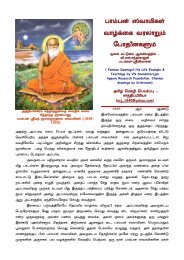MALAYSIAN HINDU PILGRIMAGE: KAVADI ... - Murugan Bhakti
MALAYSIAN HINDU PILGRIMAGE: KAVADI ... - Murugan Bhakti
MALAYSIAN HINDU PILGRIMAGE: KAVADI ... - Murugan Bhakti
Create successful ePaper yourself
Turn your PDF publications into a flip-book with our unique Google optimized e-Paper software.
water and tips these over the crown of the head (the majority of participants who have gathered alongthe river bank will use the specially constructed bathing facilities). The participant will then be daubedwith the standard Saivite markings of vibhuti (holy ash).The devotee is then put into a trance. He/she concentrates on the deity while those gathered aroundshout “Vel! Vel!. (“Spear! Spear!”) or “Aroogara” (“Praise to the Lord”), all chants pertinent to theworship of <strong>Murugan</strong>. Further stimulation may be provided through music, especially drumming, andincense may be waved in the devotee’s face. The onset of the trance is obvious to all bystanders, and ismarked with a host of visible body signals, which may include trembling, exaggerated facialcontortions, buckling at the knees.It is at this point that the vel-s are fitted. As the insertions are performed the leader’s assistants and theaspirant’s supporters gather round him/her and chant loudly and close to the devotee’s ears. I havenoted that one of these vel-s will be pushed through the tongue, the other through the cheeks. Theseindicate firstly that the pilgrim has renounced the gift of speech (thus fulfilling the ascetic vow ofmauna or silence) so that he/she may concentrate more fully upon <strong>Murugan</strong>, and secondly that thedevotee has passed wholly under the protection of the deity who will not allow him/her to shed bloodor suffer pain. By permitting the vel to pierce the flesh the aspirant is also highlighting the transience ofthe physical body as opposed to the enduring power of Truth. If the devotee is to bear one of the morecomplex kavadis, this will now be fitted and the hooks or needles inserted into the torso.Simons et al (p.263) claims that the trance is invariably possessive and amnesiac. This is not theexperience of the majority of kavadi bearers with whom I have been associated and others whom Ihave interviewed. In many, if not most cases, the violence of the initial trance state recedes and isreplaced by a condition the devotee reports as a form of “supercharged” awareness; “operating at ahigher level” is a frequent comment. In this state the devotee is cognizant of all that is happeningaround him/her and is able to respond positively to practical directions given by the retinue escortinghim/her but feels himself/herself to be functioning at a level infinitely superior to mundaneconsciousness. This has also been my own experience. The ideal trance state at Thaipusam is knownas arul (state of grace) and is clearly distinguishable in Tamil belief structures from “lesser” trancestates, hysteria, or possession by “little” deities or even asura-s. Arul occurs when the god “mounts”the devotee, so that he/she assumes the role of <strong>Murugan</strong>’s vahana. The elaborate peacock motifs onmost kavadis recollect for the majority of devotees the final form of Surapadman whom <strong>Murugan</strong>tamed; similarly their mundane natures are now “tamed’ and subordinated to the deity’s control.Once the kavadi has been fitted, devotees set off to their destination surrounded by an escorting groupwho urge the devotee on with chanting, and renditions of a recognized corpus of kavadi songs knownas kavadi-c-cindu (Lakshmanan Chettiar). The group also forms a protective ring around the kavadiworshipper, Along the route the devotee will engage in a ritualized dance known coloquially as the“kavadi” dance, based upon the asura Itampan’s swaying movements as he bore the hills, the futureabode of <strong>Murugan</strong>, slung on a pole. The kavadi dance also reflects the long history of dance as anintegral form of <strong>Murugan</strong> worship, and his role as Lord of the Dance. (Zvelebil:1991: pp33-35).The devotees make their way, often through considerable congestion toward the Batu Caves complex.On their way they complete a journey dense with symbolism. All kavadi bearers will cross the bridgeover the nearby river, thus signalling that they have begun the final stage of the tirtha-yatra. They willenter the Batu Caves complex through gates decorated with motifs of the peacock, <strong>Murugan</strong>’sdomesticated vahana. At the foot of the 272 steps leading to the main cave, they will pass a smalltemple dedicated to Ganesha, controller of access to the spiritual cakra-s. They will also pass under anarchitrave featuring a murthi of Shanmugam, the unstabilized and early form of <strong>Murugan</strong>. They willclimb the steps, representing the ascent through the sacred cities, the higher cakra-s. At the top of thestairway, immediately to the right of the cave, they will encounter the shrine to Itampan, gatekeeper ofthe Sri Subramanya Kovil. Nearly all interviewees report a sense of “urgency” once they reach the footof the 272 steps leading to the main cave, a “pull” towards the shrine which escalates as they ascendthe steps and enter the cave. At the railing outside the main shrine the devotee will supplicate to themurthi within, <strong>Murugan</strong> and his Vel, representing the fusion of Siva/Sakti; the embodiment of DivineGrace. Many aspirants, overcome by emotion, weep openly. The milk, borne in a pot slung from thekavadi, is passed to one of the pucari-s within the shrine, and is poured over the golden Vel. The


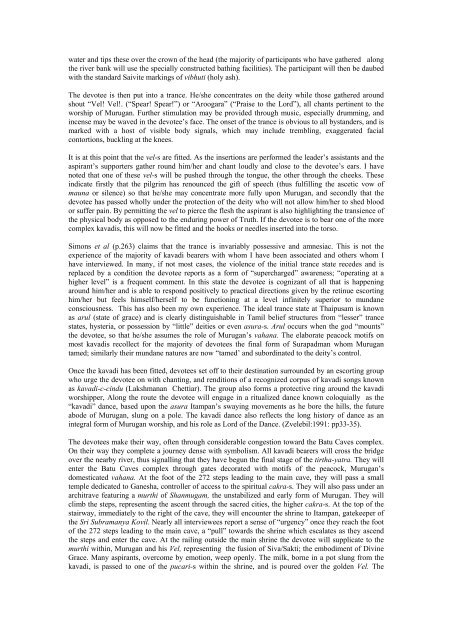
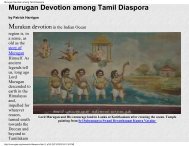
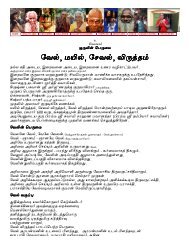
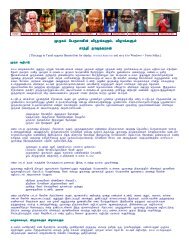
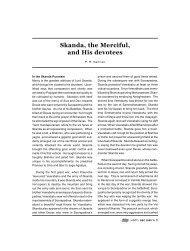

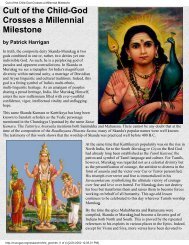
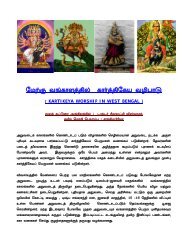
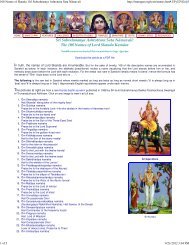
![gHdp k]y Myaj;jpw;F ghj ahj;jpiu fpuhkpa gHf;f Kiwfs;](https://img.yumpu.com/10245948/1/184x260/ghdp-ky-myajjpwf-ghj-ahjjpiu-fpuhkpa-ghff-kiwfs.jpg?quality=85)

